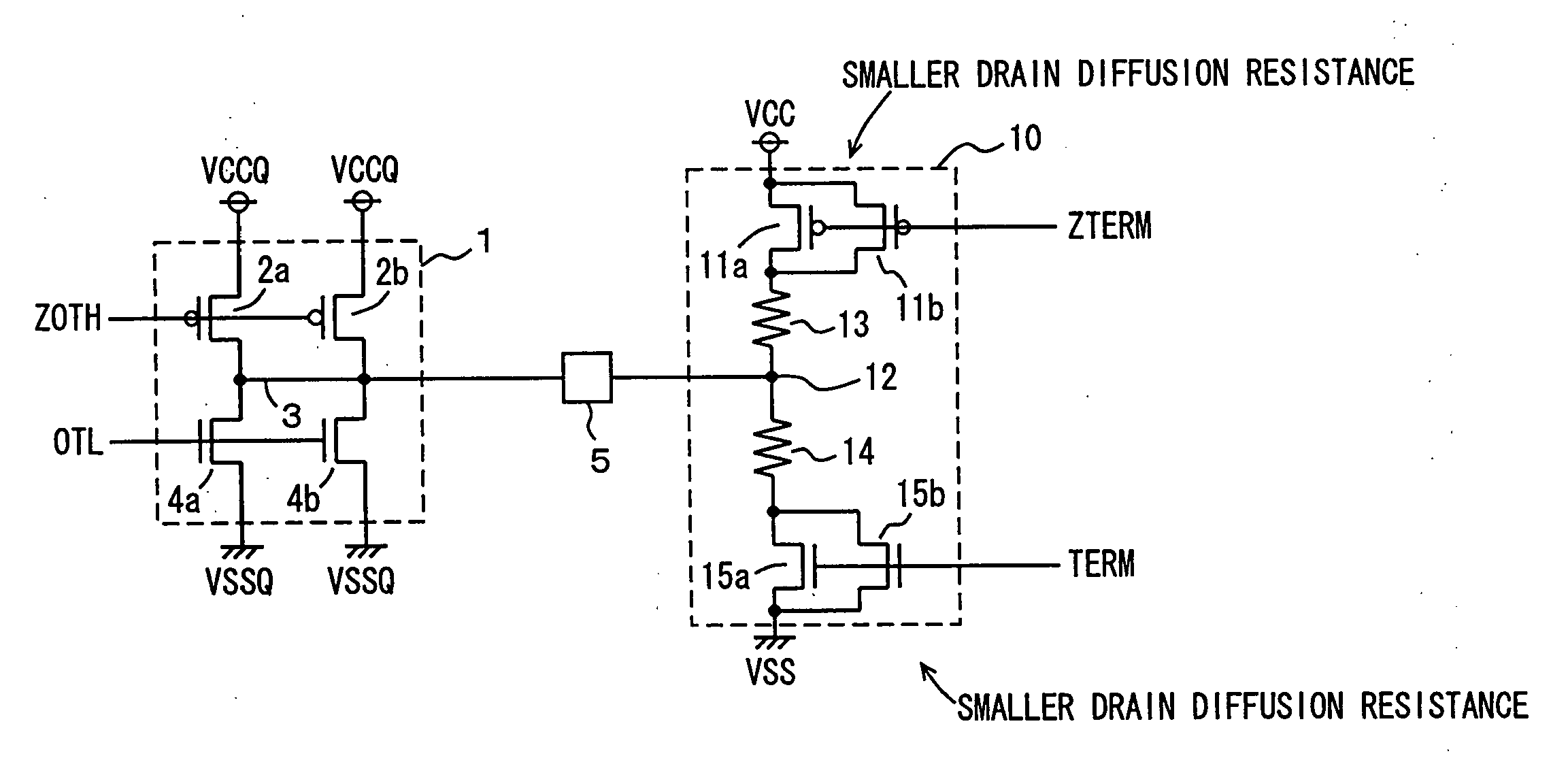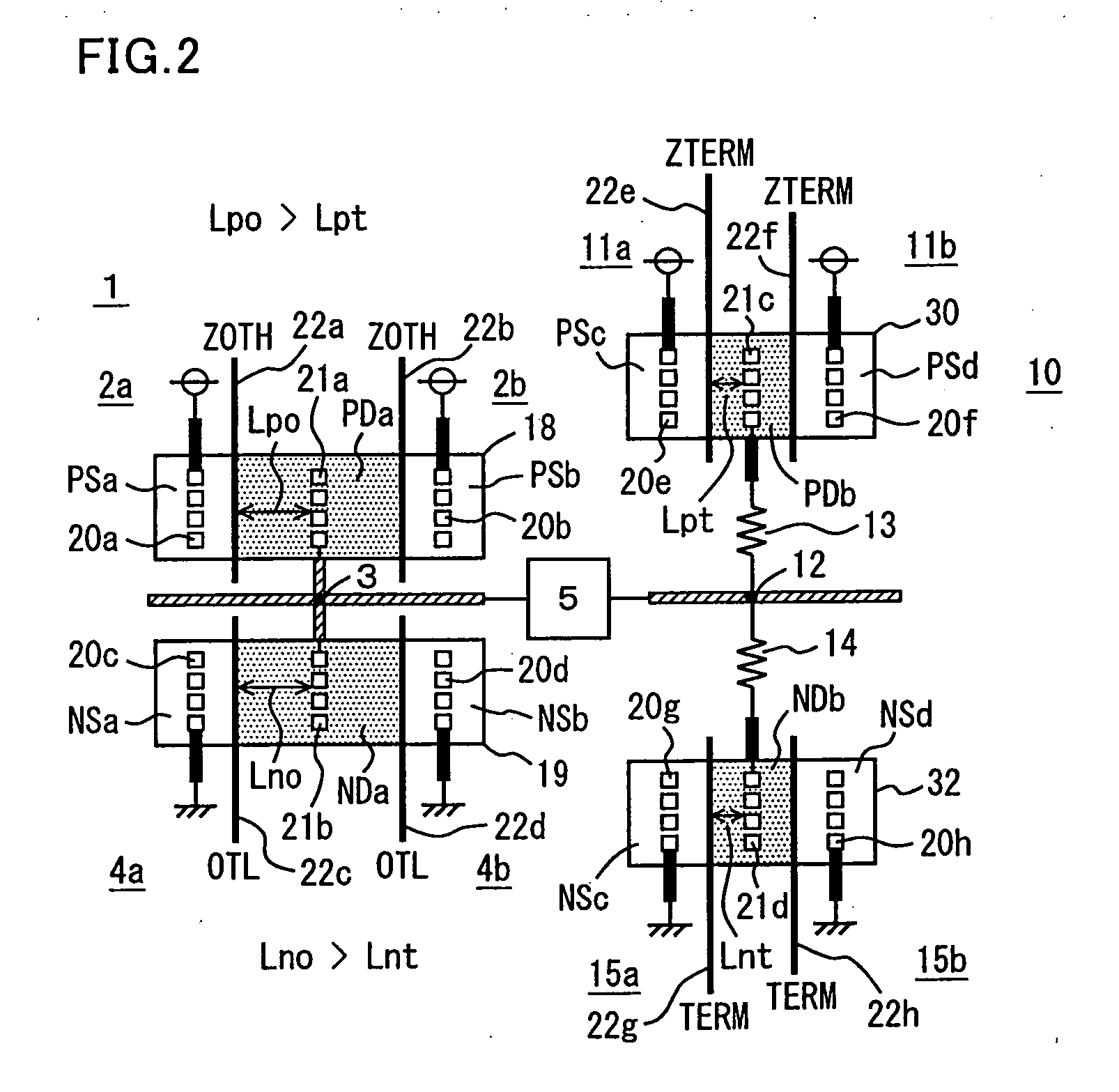Semiconductor device with bus terminating function
a technology of a semiconductor device and a bus, applied in the field of semiconductor devices, can solve the problems of low reliability, signal cannot be transmitted at high speed, and electrical static damage, and achieve the effects of high speed, accurate transmission of signals, and high speed
- Summary
- Abstract
- Description
- Claims
- Application Information
AI Technical Summary
Benefits of technology
Problems solved by technology
Method used
Image
Examples
first embodiment
[0038] First Embodiment
[0039]FIG. 1 shows a configuration of a main part of a semiconductor device according to a first embodiment of the present invention. In FIG. 1, an output circuit 1 and a terminating circuit 10 provided for an external output pad 5 are representatively shown. Pad 5 is connected to a pin terminal, which is not shown.
[0040] Output circuit 1 includes P-channel MOS transistors 2a and 2b each connected between a power supply node and an output node 3 and selectively made conductive in accordance with an output control signal ZOTH, and N-channel MOS transistors 4a and 4b each connected between output node 3 and a ground node and selectively made conductive in accordance with an output control signal OTL. Power supply voltage VCCQ for the output circuit is supplied to the power supply node, and ground voltage VSSQ for the output circuit is supplied to the ground node. Output node 3 is connected to output pad 5.
[0041] The logic levels of output control signals ZOTH ...
first modification
[0071] First Modification
[0072]FIG. 3 schematically shows a layout of transistors in output circuit 1 and terminating circuit 10 according to a first modification of the first embodiment of the present invention. The layout of the semiconductor circuit device shown in FIG. 3 is different from that of FIG. 2 in the following points. No pulling-down termination circuit portion is provided in terminating circuit 10. Terminating resistance element 13 and P-type active region 30 forming P-channel MOS transistors 11a and 11b are provided. In P-type active region 30, the distances Lpt from drain contact 21c to gate electrode 22e and to gate electrode 22f, respectively, are set sufficiently shorter as compared with the corresponding distance Lpo of P-channel MOS transistors included in output circuit 1. In this case, the distance Lpt is set shorter than the drain contact-to-gate electrode distance Lno of N-channel MOS transistors of output circuit 1.
[0073] The other configuration of the ci...
second modification
[0081] Second Modification
[0082]FIG. 5 schematically shows the layout of an output circuit and a terminating circuit according to a second modification of the first embodiment of the present invention. The layout shown in FIG. 5 is different from the layout shown in FIG. 2 in the following points. P-type active region 18 is not arranged, but an N-type active region 19 is arranged in output circuit 1. The distance between drain contact 21b and gate electrode 22c in N-type active region 19 is set to Lno. Source impurity regions NSa and NSb are coupled to ground nodes via source contacts 20c and 20d, respectively.
[0083] In output circuit 1, MOS transistors 4a and 4b are arranged to drive output node 3 in accordance with output control signal OTL applied to gate electrodes 22c and 22d. Accordingly, the output circuit 1 drives the external signal line via output pad 5, according to the open-drain scheme.
[0084] The configuration of terminating circuit 10 is similar to the layout of term...
PUM
 Login to View More
Login to View More Abstract
Description
Claims
Application Information
 Login to View More
Login to View More - R&D
- Intellectual Property
- Life Sciences
- Materials
- Tech Scout
- Unparalleled Data Quality
- Higher Quality Content
- 60% Fewer Hallucinations
Browse by: Latest US Patents, China's latest patents, Technical Efficacy Thesaurus, Application Domain, Technology Topic, Popular Technical Reports.
© 2025 PatSnap. All rights reserved.Legal|Privacy policy|Modern Slavery Act Transparency Statement|Sitemap|About US| Contact US: help@patsnap.com



